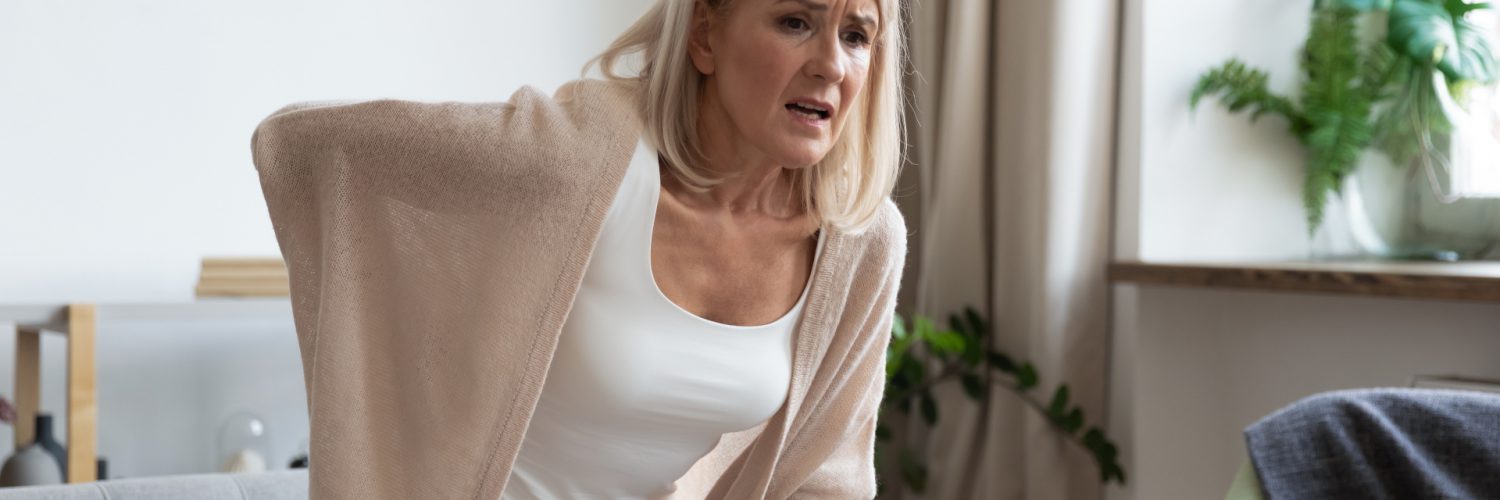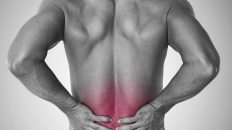Nephrolithiasis, otherwise known as urolithiasis, is a condition in which kidney stones appear in the urinary system. They are formed from chemicals that naturally occur in the urine. One of the main symptoms of kidney stones is renal colic, which is severe pain in the kidney area. Find out what the causes and symptoms of kidney stones are, what the treatment is like and how vibrotherapy can help.
What is a nephrolithiasis?
Nephrolithiasis is a condition that involves the formation of deposits in the urinary system of parts of the urinary tract (kidneys or urinary tract). It is considered a relatively common disease, affecting between 5 and 10% of the general population.It most often affects people between 30 and 50 years of age, but it is worth bearing in mind that it usually does not produce any symptoms for many years. Sometimes the removal of kidney stones can get rid of them permanently; drinking plenty of fluids and a proper diet is sometimes enough. However, sometimes the stones and the renal colic recur. In this case, it is necessary to see a doctor, because treatment is needed and the underlying cause of the kidney stones must be found out.
What are kidney stones?
In the course of nephrolithiasis, stones form in the urinary system. They are most commonly found in the kidneys, but can also occur in the bladder or ureter. They consist of substances that are present in a dissolved form and excreted with the urine in a model state. The problem with kidney stones is reaching more and more people.Unfortunately, it sometimes happens that they start to combine into a solid form and with the recommendation of the doctor it is with suitable tools to break up the lingering urinary stones into smaller fragments. Initially they take the form of sand in the kidneys, but later they already qualify as stones. They are formed from calcium phosphate or oxalate, uric acid or magnesium ammonium phosphate.
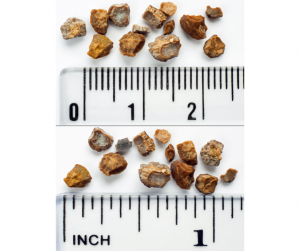
Causes of kidney stones
Stones occur due to abnormal urine pH, infections, urinary stasis or general urinary tract problems. The use of certain medications or the presence of diseases such as Crohn’s Disease also promote stone formation. Kidney stones are becoming a disease of the 21st century.
Drink plenty of fluids
A common cause of the condition is the consumption of insufficient amounts of substances that prevent the crystallisation of metabolic products. An example of such compounds is, for example, magnesium. Nephrolithiasis can also be caused by prolonged intake of too little water per day, which causes excessive concentration of urine that does not excrete compounds to form deposits.
Symptoms of kidney stones
The primary symptom of nephrolithiasis is the aforementioned renal colic, which is a severe pain of a spasmodic nature. Pain occurs in the kidney region, lumbar region or abdominal fossa. The pain alternately intensifies and stops – this is known as a renal colic attack. This may be followed by weakness, vomiting, haematuria, burning sensations, frequent urination, a feeling of pressure on the bladder and a feeling of incomplete emptying of the bladder.With kidney stones, symptoms are usually already present in the advanced stage of the disease. Earlier, stones may be asymptomatic and have no symptoms at all, and are sometimes discovered accidentally during examinations such as a kidney ultrasound. There is then a chance to avoid unpleasant symptoms by following medical recommendations, changing the lifestyle and taking care of the urinary system. It is worth consulting your doctor to avoid urological intervention and treatment in the future.
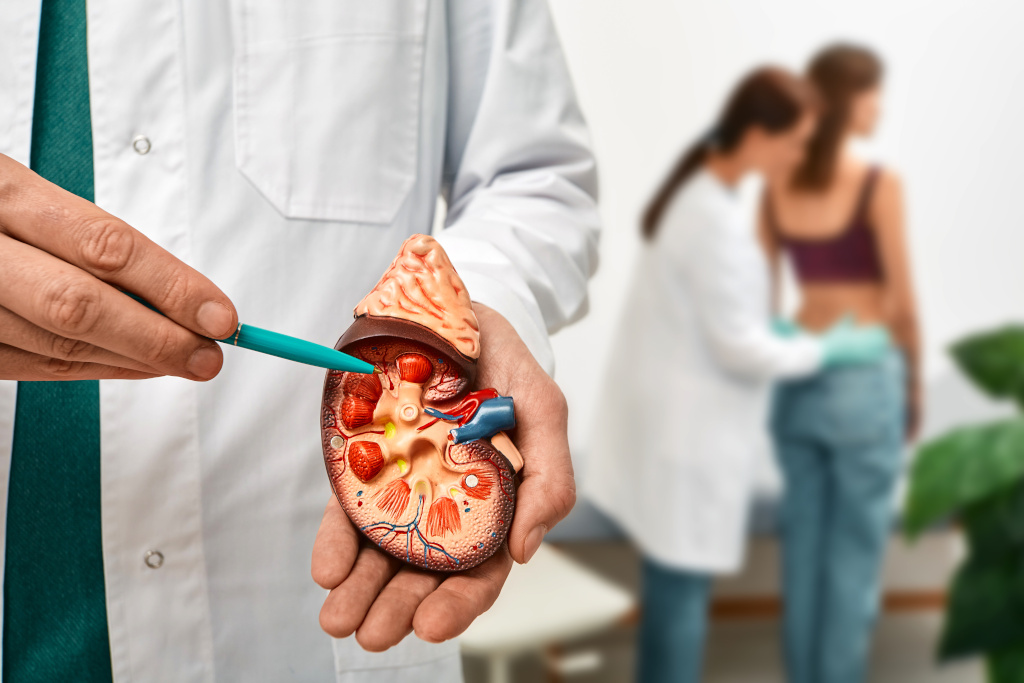
Ways of removing kidney stones – treatment of kidney stones
Today, surgical interventions for the presence of kidney stones in the urinary tract are becoming less common. Doctors are more often turning to methods such as:
Extracorporeal lithotripsy – which is a urological procedure that aims to break up a kidney stone extracorporeally. This uses what is known as a shock wave, which destroys the deposits and converts them into sand, which can be independently excreted with the urine. There may be mild haematuria for 2 days after the procedure, as well as lower abdominal pain. In the case of large stones, the procedure may need to be repeated. Lithotripsy does not require a stay in hospital and does not require anaesthesia.
Percutaneous nephrolithotripsy – a method used for large kidney stones. The procedure involves incising the skin, inserting a nephroscope into the body and breaking the deposit into smaller pieces. Nephrolithotripsy is slightly more invasive than the previous method, but really large stones can be removed with the right tools. It requires a stay for several days in the ward and the administration of anaesthesia. There may be an elevated temperature and other discomfort as the procedure requires anaesthesia in the lower abdomen.
Ureterorenoscopy – is a procedure that is performed under anaesthesia when severe pain is already present and treatment without medical intervention is unavoidable. It involves inserting a speculum (flexible speculum) through the urethra, guiding it through the bladder up to the ureter (external genitalia). During the procedure, it is possible to remove the stone completely or to grind it into smaller pieces with suitable instruments. For a few days after the procedure, the patient is fitted with a special catheter. On the doctor’s advice, it may be necessary to take painkillers and take special care with hygiene to avoid urinary tract disease.
The appropriate method of treatment is chosen by the doctor, based on the size of the deposit, the number of stones, and the location of the stone. Sometimes it is not possible to remove an inappropriately located stone (bladder stones) by lithotripsy and more invasive methods are required.
Nephrolithiasis and physical treatments
Physiotherapy can also help with chronic pain and other symptoms of stones. Although in most cases it will not remove or reduce the stones, it will relieve the pain and discomfort associated with having them. Painkillers will be unnecessary. Standard physical treatments of choice for kidney stones include:
- Short-wave diathermy – based on heat and the application of low-frequency currents. This can accelerate excretion if we can crush the stones most often found in the renal pelvis beforehand.
- Diadynamic currents – another electrotherapy method. Depending on the selected strength of the currents, various effects can be achieved – stimulating regeneration, relieving pain or improving circulation.
- Infrared irradiation – also abbreviated as IR, also used for the treatment of pain or excessive muscle tension. For the majority of patients, it is used together with a method using currents.
Physical methods for eliminating the cause of kidney stones also include vibrotherapy, which has very good results in the treatment and prevention of kidney stones.
Renal colic is often accompanied by acute abdominal pain, pain in the kidney area and other symptoms that give us a signal that our body cannot cope with the excretion of certain elements. Therefore, do not underestimate abdominal pains that are recurrent. And if we are not sure what is causing them, let us consult a specialist, namely a nephrologist. This is a person who deals with diseases of the kidneys and urinary system.
How does vibrotherapy help with kidney stones?
Vibrotherapy is used to treat kidney stones both on its own and as an adjunct, e.g. after a lithotripsy procedure or to prevent the formation of further deposits.
Vibrotherapy is a method that allows smaller deposits to be more easily removed from the urinary tract. It also allows the effects of standard treatment methods to be amplified. Before a person with kidney stones is qualified for treatment, vibrotherapy will help reduce the pain and discomfort that occurs due to the presence of deposits prior to the formation of a kidney stone.
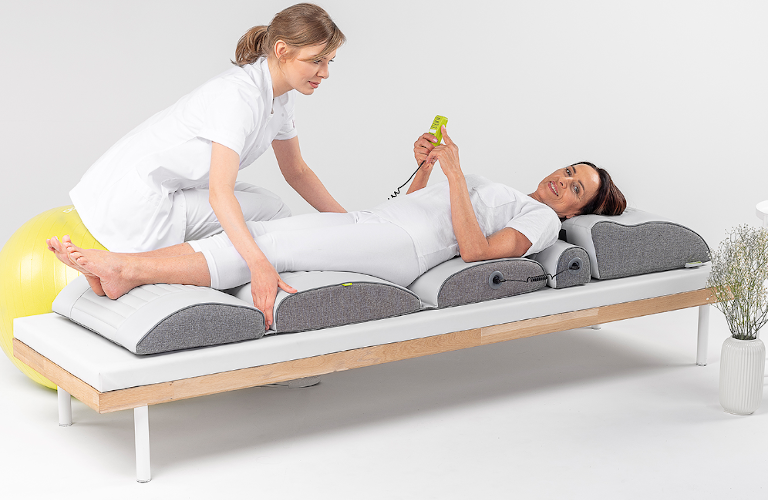
A major advantage of this type of therapy is its complete non-invasiveness and lack of side effects. Vibrotherapy can be applied to people of any age, even patients with hyperparathyroidism or mobility problems. It is completely painless and the treatment, carried out using vibrotherapy equipment such as the Vitberg RS 2, is extremely comfortable. It is also possible to perform it at home.
What other benefits can be derived from vibrotherapy?
Mechanical vibration prevents the crystallisation of metabolic products in the urinary tract (e.g. uric acid accumulation), reduces pain and strengthens muscle tissue. They also make it possible to significantly improve circulation and thus nourish and oxygenate tissues and systems in the correct way. It can nullify an attack of renal colic to nothing.
Kidney stones and vibrotherapy sessions?
To test the effects of the therapy, you can go to one of the Vitberg Clinics or buy your own vibrotherapy set – Vitberg RS Base Device and possibly additional modules. After the first visit, we may feel fewer symptoms. As Vitberg devices are perfectly tested, used in hospitals and sanatoriums, you can be sure that vibrotherapy with their use is completely safe and has a positive effect not only on kidney stones but also on the whole body.
Prevention of kidney stones
To avoid the formation of kidney stones, it is a good idea to start paying a little more attention to what you provide your body with. It is a good idea to eliminate products containing high levels of oxalates from your diet.You should regularly consume low-mineralised still water in quantities adapted to your age and weight. It is assumed that 35 millilitres of water should be consumed for every kilogram of body weight. Beware of excessive intake of vitamin D.If there is already sand in the urinary tract, the amount of fluids consumed should be increased. Herbs with a diuretic effect can also be used. If you have any urinary tract problems or symptoms, it is a good idea to consult with your GP about the preventive steps you are taking and get the right treatment.
References:
Efficacy and Safety of External Physical Vibration Lithecbole After Extracorporeal Shock Wave Lithotripsy or Retrograde Intrarenal Surgery for Urinary Stone: A Systematic Review and Meta-analysis. Yuan C, Jian Z, Jin X i wsp. J Endourol. 2021 May;35(5):712-720.

